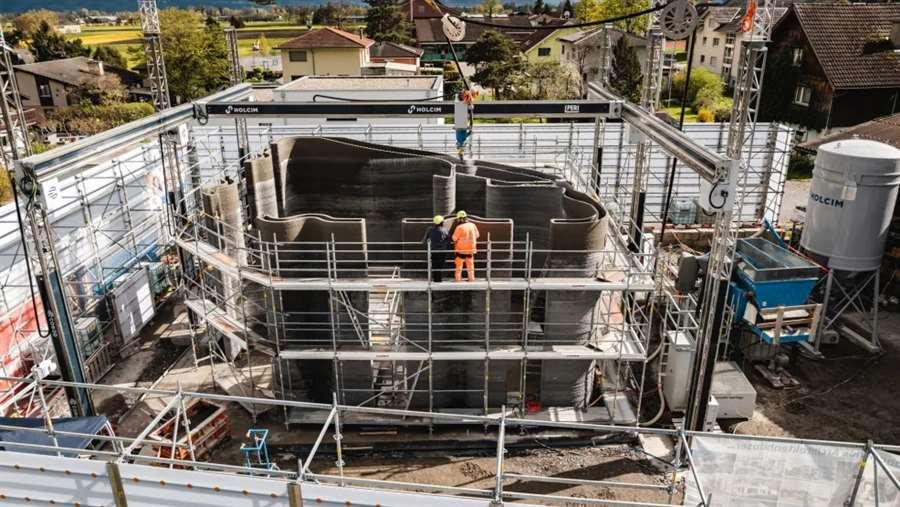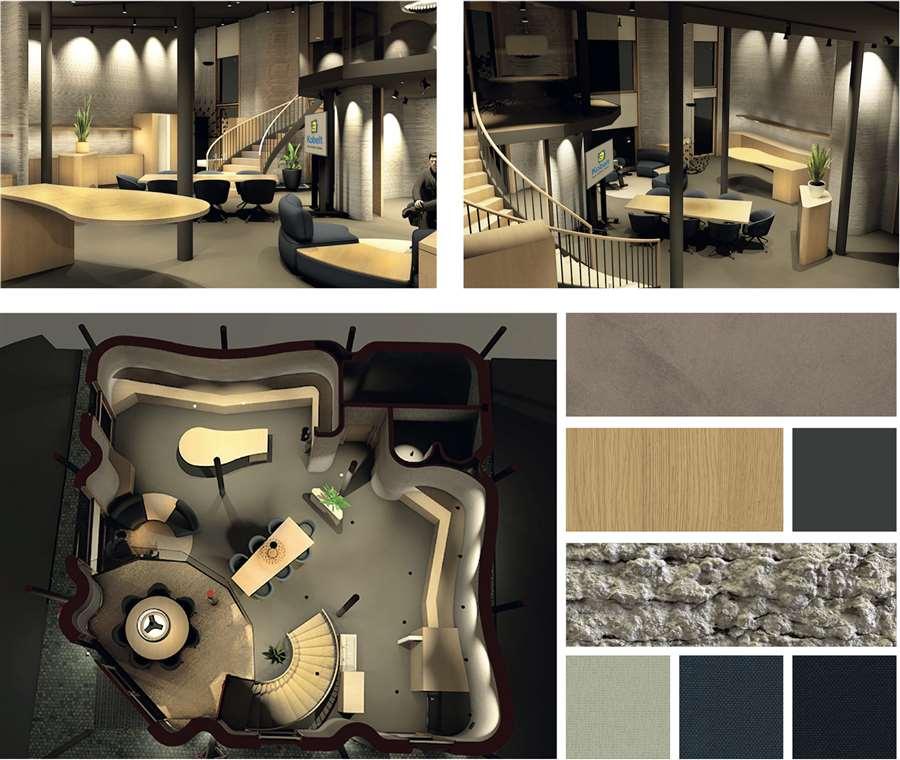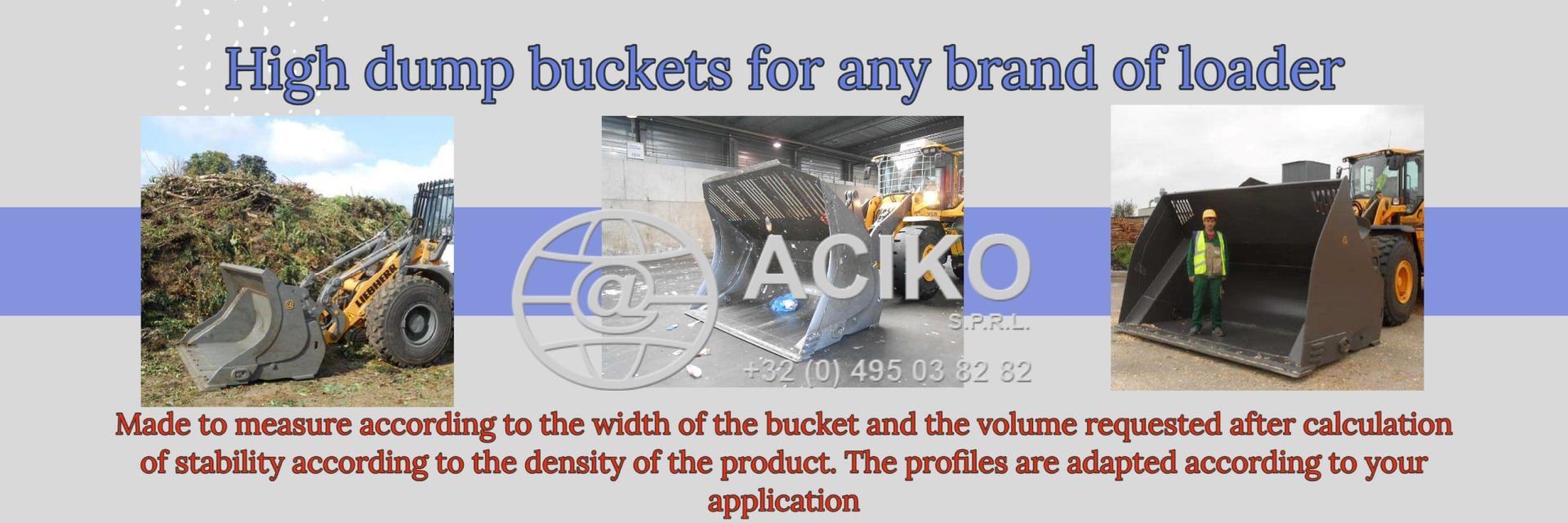R.E.News future Technology-Holcim, Peri claim 3D-printing ‘first’ in Switzerland
 07/06/24-FR-English-NL-footer
07/06/24-FR-English-NL-footer
Holcim et Peri revendiquent la « première » de l’impression 3D en Suisse

 Holcim, Peri, and COBOD collaborate on this ‘first in Switzerland’ on-site 3D concrete printed building. (Image: COBOD)-Renders of the showroom and, on bottom right, the materials and colour schemes used for the 3D-printed structure. (Image provided by Holcim)
Holcim, Peri, and COBOD collaborate on this ‘first in Switzerland’ on-site 3D concrete printed building. (Image: COBOD)-Renders of the showroom and, on bottom right, the materials and colour schemes used for the 3D-printed structure. (Image provided by Holcim)
Holcim, un fournisseur mondial de matériaux et de granulats de construction, a déclaré avoir construit sur place à Saint-Gall, en Suisse, un bâtiment imprimé en béton 3D pour un client, avec l'aide de Peri. Selon Holcim, il s’agit d’une « première » pour le pays.
Le projet était une salle d'exposition modèle de 150 m2 (1 614 pieds carrés) pour l'entreprise de construction et de rénovation Kobelt AG. La structure comporte des murs en béton incurvés imprimés jusqu'à une hauteur de 6,2 m (20 pieds).
L’imprimante était une unité de construction 3D BOD2 de COBOD, basée au Danemark. Holcim et Peri, le fabricant allemand de coffrages et d'échafaudages, sont tous deux actionnaires minoritaires de COBOD.
Environ 60 m3 (2 119 pieds cubes) du nouveau mélange de béton d'Holcim ont été utilisés, ce qui s'écarte du mélange de mortier généralement utilisé dans le segment de l'impression 3D.
Henrik Lund-Nielsen, fondateur et directeur général de COBOD, a commenté : « Nous félicitons Holcim pour le développement du nouveau béton réel imprimable en 3D.
« Depuis longtemps, nous préconisons l'impression avec du vrai béton et non avec des mortiers, car l'impression avec des mortiers entraîne l'utilisation de plus de ciment, des émissions de CO2 et des coûts plus élevés. »
La durée du projet était de 55 heures réparties sur huit jours.
Explorer les possibilités de l'impression 3D
Selon Holcim, Kobelt – qui a principalement une expérience dans la construction en bois – a contacté le groupe des matériaux et granulats pour « explorer et tester les possibilités de l'impression 3D dans la construction ».
Conscient du besoin d'une salle d'exposition, mais avec un espace limité, Kobelt a contacté Holcim.
"Reconnaissant la nouveauté de la technologie, Holcim Suisse s'est associée à la société expérimentée Peri 3D Construction pour l'aider dans le projet", a déclaré Holcim.
La structure était basée sur des designs minimalistes combinant le bois et les murs en béton imprimé.
Servant d'espace de bureau modèle, le bâtiment contient des zones divisées comprenant des zones de réunion, des présentoirs d'échantillons, un coin pour enfants, une cuisine-café et une salle de réunion séparée accessible par un escalier arrondi.
Lund-Nielsen a noté que l'initiative a également contribué à mettre en valeur les gains de durabilité et d'efficacité des bâtiments imprimés en béton et a encouragé le segment à explorer les pâtes sans mortier pour l'avenir.
« Nous devons réduire l’empreinte CO2 du secteur de la construction », a-t-il déclaré. "C'est ce que nous pouvons réaliser en imprimant en 3D des conceptions économes en matériaux avec du vrai béton, et non des mortiers."
NJC.© Info HOLCIM Peri
-------------------------------------------------------------------------------------------------------------------
 07/06/24-English
07/06/24-English
Holcim, Peri claim 3D-printing ‘first’ in Switzerland

 Holcim, Peri, and COBOD collaborate on this ‘first in Switzerland’ on-site 3D concrete printed building. (Image: COBOD)-Renders of the showroom and, on bottom right, the materials and colour schemes used for the 3D-printed structure. (Image provided by Holcim)
Holcim, Peri, and COBOD collaborate on this ‘first in Switzerland’ on-site 3D concrete printed building. (Image: COBOD)-Renders of the showroom and, on bottom right, the materials and colour schemes used for the 3D-printed structure. (Image provided by Holcim)
Holcim, a global provider of building materials and aggregates, said it constructed on-site in St. Gallen, Switzerland, a 3D concrete-printed building for a client, with assistance from Peri. According to Holcim, it’s a ‘first’ for the country.
The scheme was a 150m2 (1,614 sq ft) model showroom for construction and renovation firm Kobelt AG. The structure features curved concrete walls printed up to a height of 6.2m (20 ft).
The printer was a BOD2 3D construction unit from Denmark-based COBOD. Both Holcim and Peri, the German-based formwork and scaffolding manufacturer, are minority shareholders of COBOD.
About 60m3 (2,119 cu ft) of Holcim’s novel concrete mix was used, which was a departure from the mortar mix generally used across the 3D-printing segment.
Henrik Lund-Nielsen, COBOD’s founder and general manager, commented, “We congratulate Holcim on the development of the new 3D printable real concrete.
“For long we have been advocating printing with real concrete and not mortars, as the printing with mortars leads to use of more cement, higher CO2 emissions and costs.”
The project runtime was 55 hours across eight days.
Exploring the possibilities of 3D printing
According to Holcim, Kobelt – which has experience predominantly constructing with wood – contacted the materials and aggregates group to “explore and test the possibilities of 3D printing in construction”.
Recognising the need for a showroom, but with limited space, Kobelt reached out to Holcim.
“Recognizing the novelty of the technology, Holcim Switzerland partnered with the experienced Peri 3D Construction to assist with the project,” said Holcim.
The structure was based on minimalist designs that combine wood with the concrete printed walls.
Serving as a model office space, the building contains divided zones including meeting areas, sample displays, a children’s corner, a coffee kitchen, and a separate meeting room accessed by a rounded staircase.
Lund-Nielsen noted the initiative also helped showcase the sustainability and efficiency gains of concrete-printed buildings and encouraged the segment to explore non-mortar pastes for the future.
“We need to lower the CO2 footprint of the construction sector,” he said. “This we can achieve by 3D-printing material-efficient designs with real concrete, not mortars.”
NJC.© Info HOLCIM Peri
------------------------------------------------------------------------------------------------------------------
 07/06/24-NL
07/06/24-NL
Holcim en Peri claimen dat 3D-printen ‘eerst’ is in Zwitserland

 Holcim, Peri, and COBOD collaborate on this ‘first in Switzerland’ on-site 3D concrete printed building. (Image: COBOD)-Renders of the showroom and, on bottom right, the materials and colour schemes used for the 3D-printed structure. (Image provided by Holcim)
Holcim, Peri, and COBOD collaborate on this ‘first in Switzerland’ on-site 3D concrete printed building. (Image: COBOD)-Renders of the showroom and, on bottom right, the materials and colour schemes used for the 3D-printed structure. (Image provided by Holcim)
Holcim, een wereldwijde leverancier van bouwmaterialen en aggregaten, zei dat het ter plaatse in St. Gallen, Zwitserland, een 3D-betongeprint gebouw voor een klant heeft gebouwd, met hulp van Peri. Volgens Holcim is het een ‘primeur’ voor het land.
Het plan betrof een modelshowroom van 150 m2 voor bouw- en renovatiebedrijf Kobelt AG. De constructie is voorzien van gebogen betonnen wanden die tot een hoogte van 6,2 meter (20 ft) zijn bedrukt.
De printer was een BOD2 3D-constructie-eenheid van het in Denemarken gevestigde COBOD. Zowel Holcim als Peri, de in Duitsland gevestigde fabrikant van bekistingen en steigers, zijn minderheidsaandeelhouders van COBOD.
Er werd ongeveer 60 m3 van het nieuwe betonmengsel van Holcim gebruikt, wat afwijkt van het mortelmengsel dat doorgaans in het 3D-printsegment wordt gebruikt.
Henrik Lund-Nielsen, oprichter en algemeen directeur van COBOD, zei: “We feliciteren Holcim met de ontwikkeling van het nieuwe 3D-printbare echte beton.
“Wij pleiten al lang voor het printen met echt beton en niet met mortels, omdat het printen met mortels leidt tot meer cementverbruik, hogere CO2-uitstoot en hogere kosten.”
De looptijd van het project bedroeg 55 uur, verdeeld over acht dagen.
Onderzoek naar de mogelijkheden van 3D-printen
Volgens Holcim heeft Kobelt – die ervaring heeft met voornamelijk bouwen met hout – contact opgenomen met de materialen- en aggregatengroep om “de mogelijkheden van 3D-printen in de bouw te onderzoeken en te testen”.
Kobelt erkende de behoefte aan een showroom, maar met beperkte ruimte, en nam contact op met Holcim.
“Holcim Zwitserland erkende de nieuwigheid van de technologie en werkte samen met de ervaren Peri 3D Construction om te helpen bij het project”, aldus Holcim.
De structuur was gebaseerd op minimalistische ontwerpen die hout combineren met de betonnen bedrukte muren.
Het gebouw doet dienst als modelkantoorruimte en bevat verdeelde zones, waaronder vergaderruimtes, voorbeelddisplays, een kinderhoek, een koffiekeuken en een aparte vergaderruimte die toegankelijk is via een ronde trap.
Lund-Nielsen merkte op dat het initiatief ook heeft bijgedragen aan het onder de aandacht brengen van de duurzaamheids- en efficiëntiewinsten van met beton bedrukte gebouwen en het segment heeft aangemoedigd om niet-mortelpasta's voor de toekomst te onderzoeken.
“We moeten de CO2-voetafdruk van de bouwsector verkleinen”, zei hij. “Dit kunnen we bereiken door materiaalefficiënte ontwerpen in 3D te printen met echt beton, en niet met mortels.”
NJC.© Info HOLCIM Peri
--------------------------------------------------------------------------------------------------------------------
Date de dernière mise à jour : 06/06/2024
















